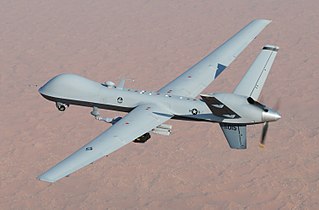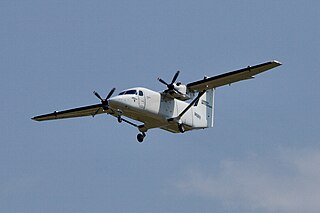
The Northrop Grumman RQ-4 Global Hawk is a high-altitude, remotely-piloted surveillance aircraft introduced in 2001. It was initially designed by Ryan Aeronautical, and known as Tier II+ during development. The RQ-4 provides a broad overview and systematic surveillance using high-resolution synthetic aperture radar (SAR) and electro-optical/infrared (EO/IR) sensors with long loiter times over target areas.

An unmanned aerial vehicle (UAV), or unmanned aircraft system (UAS), commonly known as a drone, is an aircraft with no human pilot, crew, or passengers onboard. UAVs were originally developed through the twentieth century for military missions too "dull, dirty or dangerous" for humans, and by the twenty-first, they had become essential assets to most militaries. As control technologies improved and costs fell, their use expanded to many non-military applications. These include aerial photography, area coverage, precision agriculture, forest fire monitoring, river monitoring, environmental monitoring, weather observation, policing and surveillance, infrastructure inspections, smuggling, product deliveries, entertainment, and drone racing.

The Piaggio P.180 Avanti is an executive/VIP light transport aircraft, designed by Piaggio Aero and built in Italy. It features twin, wing-mounted turboprop engines, in a pusher configuration. The Avanti seats up to nine people in a pressurized cabin and may be flown by one or two pilots. The design is of three-surface configuration, having both a small forward wing and a conventional tailplane, as well as its main wing, with the main wing spars passing behind the passenger cabin area. The FAI lists it as the fastest propeller-driven aircraft with speed of 927.4 km/h.

The PAC P-750 XSTOL, is a utility aircraft of conventional all-metal low-wing monoplane design, with fixed tricycle undercarriage. Combining the engine and wings of the PAC Cresco with a new larger fuselage and modified tail, all versions to date have been powered by a 750 hp (560 kW) Pratt & Whitney Canada PT6 turboprop. It is designed and manufactured in Hamilton, New Zealand, by Pacific Aerospace Limited.

Swift Engineering is an American engineering firm that builds autonomous systems, helicopters, submarines, spacecraft, ground vehicles, robotics, and composite parts. The chairman and CEO is Hiro Matsushita, a former racecar driver and grandson of the founder of Panasonic, Konosuke Matsushita.

The General Atomics MQ-9 Reaper is an unmanned aerial vehicle capable of remotely controlled or autonomous flight operations, developed by General Atomics Aeronautical Systems (GA-ASI) primarily for the United States Air Force (USAF). The MQ-9 and other UAVs are referred to as Remotely Piloted Vehicles/Aircraft (RPV/RPA) by the USAF to indicate ground control by humans.

The Diamond DA40 Diamond Star is an Austrian four-seat, single-engine, light aircraft constructed from composite materials. Built in both Austria and Canada, it was developed as a four-seat version of the earlier DA20 by Diamond Aircraft Industries.

The TAI Anka is a family of unmanned aerial vehicles developed by Turkish Aerospace Industries primarily for the Turkish Air Force. Envisioned in the early 2000s for aerial surveillance and reconnaissance missions, Anka has evolved into a modular platform with synthetic-aperture radar, precise weapons and satellite communication.

The Zephyr is a series of high-altitude platform station aircraft produced by Airbus. They were designed originally by QinetiQ, a commercial offshoot of the UK Ministry of Defence. In July 2010, the Zephyr 7 flew for 14 days. In March 2013, the project was sold to Airbus Defence and Space. In the summer of 2022, the Zephyr 8/S flew for 64 days.
CASC Rainbow is a series of unmanned aerial vehicles (UAVs) marketed by China Aerospace Science and Technology Corporation (CASC). The series includes multi-role medium-altitude long-endurance UAVs and micro air vehicles (MAV). The UAVs are produced by CASC's China Academy of Aerospace Aerodynamics (CAAA).

A delivery drone is an unmanned aerial vehicle (UAV) designed to transport items such as packages, medicines, foods, postal mails, and other light goods. Large corporations like Amazon, DHL, and FedEx have started to use drone delivery services. Drones were used effectively in the fight against COVID-19, delivering millions of vaccines and medical supplies across the globe. Drone deliveries are highly efficient, significantly speeding up delivery times and avoiding challenges traditional delivery vehicles may encounter. Given their life-saving potential, use cases for medical supplies in particular have become the most widely tested type of drone delivery, with trials and pilot projects in dozens of countries such as Australia, Canada, Botswana, Ghana, Uganda, the UK, the US among others.
Urban air mobility (UAM) is the use of small, highly automated aircraft to carry passengers or cargo at lower altitudes in urban and suburban areas which have been developed in response to traffic congestion. It usually refers to existing and emerging technologies such as traditional helicopters, vertical-takeoff-and-landing aircraft (VTOL), electrically propelled vertical-takeoff-and-landing aircraft (eVTOL), and unmanned aerial vehicles (UAVs). These aircraft are characterized by the use of multiple electric-powered rotors or fans for lift and propulsion, along with fly-by-wire systems to control them. Inventors have explored urban air mobility concepts since the early days of powered flight. However, advances in materials, computerized flight controls, batteries and electric motors improved innovation and designs beginning in the late 2010s. Most UAM proponents envision that the aircraft will be owned and operated by professional operators, as with taxis, rather than by private individuals.

The Cessna 408 SkyCourier is an American utility aircraft designed and built by the Cessna division of Textron Aviation. It was launched on November 28, 2017, with an order for 50 from FedEx Express, with the aircraft designed for the needs of its FedEx Feeder service. It made its first flight on May 17, 2020, and was type certified on March 11, 2022. FedEx took delivery of the first production model on May 9, 2022.

Zipline International Inc. is an American company that designs, manufactures, and operates delivery drones. The company operates distribution centers in the United States, Rwanda, Ghana, Japan, Nigeria, Côte d'Ivoire, and Kenya. As of April 2024, its drones have made more than one million commercial deliveries and flown more than 70 million autonomous miles.

The Elroy Air Cargo is an unmanned cargo aircraft developed by American startup company Elroy Air, intended to replace land delivery trucks on inefficient routes with unmanned aircraft.

The TAI Aksungur is an unmanned combat aerial vehicle (UCAV) built by Turkish Aerospace Industries (TAI) for the Turkish Armed Forces. Using existing technology from the TAI Anka series of drones, it is the manufacturer's largest drone with payload capacity for mission-specific equipment. It is intended to be used for long-term surveillance, signals intelligence, maritime patrol missions, or as an unmanned combat aerial vehicle. TAI planned to integrate weapon packages and put the Aksungur into production in early 2020. The first unit was delivered to the Turkish Naval Forces on 20 October 2021.

An electric vertical take-off and landing (eVTOL) aircraft is a variety of VTOL aircraft that uses electric power to hover, take off, and land vertically. This technology came about owing to major advances in electric propulsion and the emerging need for new aerial vehicles for urban air mobility that can enable greener and quieter flights. Electric and hybrid propulsion systems (EHPS) have also the potential of lowering the operating costs of aircraft.

Wingcopter GmbH is a German aerospace company that designs and manufactures unmanned eVTOL delivery drones capable of providing last-mile delivery as well as mapping, surveying, and inspection. Their flagship drone, Wingcopter 178 Heavy Lift (HL), set the Guinness world speed record for remote-controlled tilt-rotor aircraft in 2018, flying at an average speed of 240.6 km/h. To date, the company has partnered with commercial and humanitarian organizations to perform drone delivery of critical supplies in Africa, the South Pacific, Ireland, and Scotland. During the COVID-19 pandemic, Wingcopter partnered with Thales, Skyports, and the NHS to provide beyond visual line of sight (BVLOS) delivery of medical test samples and other supplies to a hospital on a remote Scottish island. The company has been recognized by the World Economic Forum as "2020 Technology Pioneer". The company is amongst ten other drone companies to be selected by FAA to participate in a type certification program for delivery drones.

Advanced air mobility (AAM) are systems that incorporate support for next-generation transport such as such as remotely piloted, autonomous, or vertical take-off and landing (VTOL) aircraft. This includes those powered by electric or hybrid-electric propulsion.
The Corvo Precision Payload Delivery System (PPDS) is a small aerial drone originally intended for logistics, weighs 2.4 kg (5.3 lb) empty, and deliveries payloads of up to 3 kilograms (6.6 lb).


















